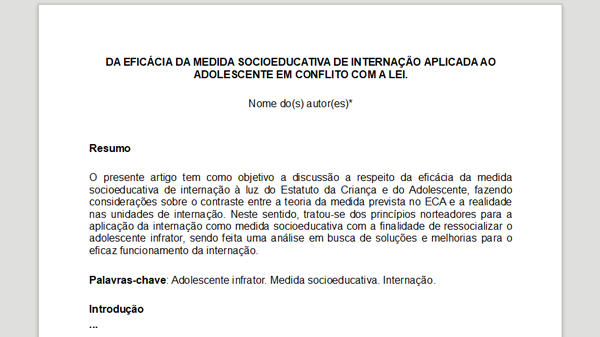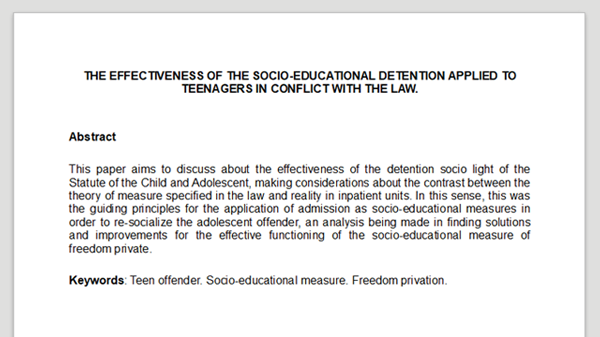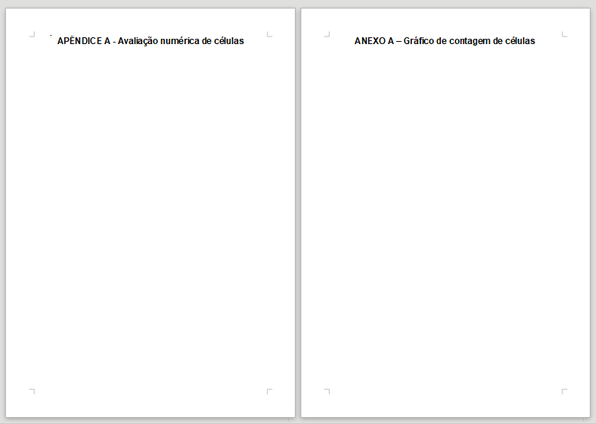The Brazilian Association of Technical Standards - ABNT, among other attributions, is responsible for standardizing the formatting of technical documents, in order to facilitate their understanding and access to knowledge scientific.
In this context, in addition to the norms aimed at academic works, ABNT edited the Brazilian Norm 6022/2003, which establishes formatting rules for scientific articles.
Considering that several faculties in Brazil already adopt the scientific article model as work of course completion, we have gathered here all the rules that must be observed when formatting your article.
Fonts, margins and spacing
Although NBR 6022/03 does not establish rules on fonts, margins and spacing, we suggest the use of the same rules applied in monographs and other academic works:
Source: size 12, with the exception of footnotes, quotes of more than three lines, pagination and image captions, which should be smaller.
margins: left and top of 3 cm, and right and bottom of 2 cm.
Spacing: must be from 1,5, with the following exceptions, which must adopt spacing simple:
- quotes over three lines
- footnotes
- references
- illustration captions and tables
Read more about formatting margins according to ABNT.
General Structure
| Structure | Elements |
|---|---|
| pre-textual |
|
| textual |
|
| Post-textual |
|
NBR 6022/03 establishes that all elements inserted in the article must be structured in the order shown in the table above.
Pre-textual elements
Pre-text elements are those presented before the content of the article and consist of the title, subtitle (if any), author's name, abstract and keywords in the language of the text. These elements must be formatted according to the example below:

Unlike monographs, pre-text elements in scientific articles must be together and on the same opening page of the content.
the summary cannot exceed 250 words and the keywords must be separated from each other by periods.
Attention: the rule also provides that the opening page must have a footnote containing a brief curriculum of the author, as well as his postal and electronic address.
Mandatory post-textual elements
Post-textual elements are presented after the conclusion of the article and can be mandatory or optional. The mandatory elements are: title, subtitle (if any), abstract and keywords, all in a foreign language and references. The first must follow this format:

Although NBR 6022/03 establishes that these elements are post-textual, it is common to find abstracts and keywords in a foreign language on the opening page of the article.
At references must follow the rules provided for in NBR 6023/02 and will be formatted as follows:

Examples taken directly from Brazilian Standard No. 6023/2002.
References should contain essential information to identify sources and, whenever possible, additional information to facilitate this recognition. Unlike monographs, references in scientific articles do not need to be on an exclusive, only after completion of the work or in footnotes.
Optional post-text elements
The optional post-textual elements are those that are at the author's discretion and consist of explanatory notes, glossary, appendices and appendices.
Although the explanatory notes are classified in this group, they are not presented after the conclusion of the article, but in footnotes throughout the text. They are used when the author feels the need to complement a point in the article, either with their own words or with quotes.
The explanatory notes and glossary will be formatted as follows:

Examples of explanatory notes taken directly from Brazilian Standard No. 6022/2003.
It is worth mentioning that the numbering of the explanatory notes does not restart on each page, but must continue consecutively to the end of the article. Regarding the glossary, it should be organized in alphabetical order.
Appendices and annexes are documents put together by the author to substantiate, prove or illustrate the content of the article, and must follow this format:
According to the example above, appendices and attachments must be identified by capital letters followed by a dash and the identification of their content.
See too:
- Examples of Formatting by ABNT Rules and Norms for academic works
- ABNT Standards for Academic Work
- Abbreviations in citations according to ABNT standards
- What is a scientific article
